 |
Utrecht Botanic Garden |
| Home Recommend This Site To A Friend |
|
by Sandy Leven. UTRECHT BOTANIC GARDEN I first heard of this garden almost 30 years ago, when the present garden was new. I intended to visit during either my 1975 or 1976 holiday to Holland and Germany. The garden is in the quiet University district of Utrecht, propitiously on Leuvenslaan, which I took to be a street with 'Leven connections'. It is easy to reach from the motorway network being just off the A28, one junction East of where it crosses the A27. Rotterdam, Den Haag and Amsterdam are all within one hour's drive of the garden. There is a large car park beside the garden. The entry charge is reasonable and as soon as you pay you make your way through the welll stocked gift shop and fresh café to the small sales area and onto a superb patio. The plants for sale are well tended and are representative of those flowering in the garden. I 'had to have' several as soon as I poked amongst them. The café has outside tables right into the patio area and beside the raised beds. 1. THE CONCRETE GARDEN The raised beds tell you that you are in a special place. Somebody here has been thinking. Remember this is Holland, the lowest lying country in Europe where stone is not just lying around to be picked up. Indeed gardeners in Holland have to import stone for their rock gardens. The alternative is to make their own stone or use the hard building materials, which are easily found. It is the latter of these that Utrecht Botanic Garden has addressed. They have developed the use of cement pipes and concrete paving into an art form. 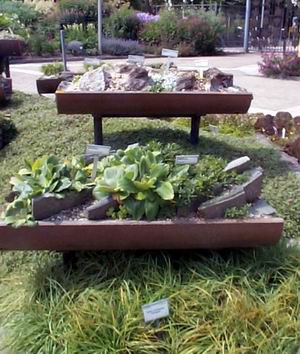
The large diameter pipes have been sawn in half longitudinally, the ends sealed with slates or rock cemented into place. Presumably there are drainage holes or maybe they drain from the sides. The pipes were raised onto a strong iron frame and then planted up. We were visiting in mid July and the main flowering in the troughs was past. The structure of the planting and stone work in each trough and their positioning made a beautiful patio feature. Troughs always look best when grouped together. These, made from totally artificial building materials were ideally suited to the hard landscaping of the patio. They had been underplanted with acaenas and ophiopogon like plants. The ground was not flat but undulating. The gentle rise and fall of this part garden contrasted with the flat patio. All the plants were well labelled which was good and bad. Good when you needed to know the name of the plant but bad aesthetically, as the labels intrude on the plants especially in photographs. Various different themes had been used in the different troughs. Different rocks contributed to their individuality. I liked the thick slate pieces, which reflected light at different angles. The slate was used to make vertical crevices and planting areas in the trough. No doubt the plant roots liked the slate surface underground where there would be a little extra moisture. There was little moss evident, except on the tufa trough. So, the garden is drier than Dunblane. Primulas, saxifrages, phloxes, salix and a host of silver plants were happy in their homes. Judicious use of dwarf conifers and trailing plants softened the hard lines of the pipes but as no attempt is made to hide the fact that this is a pipe trough garden the harsh horizontal lines are quite acceptable. By raising them as high as they have, a two tier garden has been created where the underplanting can thrive. 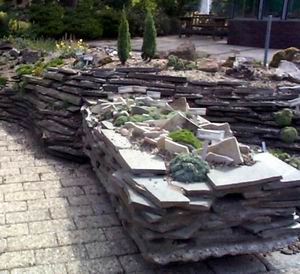
Behind the trough garden is a much harsher raised bed. The highest and largest bed is built from broken paving slabs, the kind of 3 x 2 which builders delight in putting round our houses. It must have looked very harsh when it was first built. Now the concrete has darkened and its looks have softened a bit. The fracture surfaces have chipped over the years and the exposed faces are becoming lichen covered. 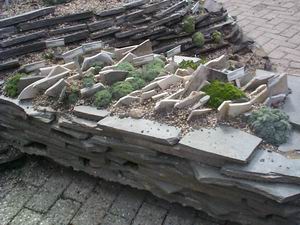
Each layer is separated from the next by a few centimetres of gravel. I suspect small chuckies have been used to ensure that the layers stay separated. There is a infinite number of planting positions between the layers. The plants growing in the wall are now quite large and there are areas with no plants, suggesting that some earlier plantings may have died. Perhaps the random nature of the wall planting is intentional. The plants growing there look good. The top of the main raised bed is landscaped with rock and gravel. Because the walls of the bed vary in height, it had been possible to contour the top surface. So what we have is a superb raised bed which is interesting from all sides, curves beside its paths and rises and falls in height as you travel round it. Two Juniperus communis compressa at the apex are the focal point. Just in front of the concrete raised bed is a surprisingly harsh bed made from slate on a concrete base. This is either a huge trough or a raised bed raised off the ground for better drainage. Growing among the vertical slates is a collection of saxifrages. The individual plants are super and are growing happily but the slate is very dominant. . As you travel round the large concrete slab raised bed you come across parts which have been built in slate. Wide layers between the slates again leave plenty room for planting. This part of the garden is just the entry to a much larger paradise for rock gardeners and for hardy plant lovers. In itself it is gives us at ideas for using non traditional materials to provide perfect homes for rock plants when we want to grow them close to modern homes and patios. I loved the geometric shapes and positioning of the troughs. The harsh horizontal lines and curved bases gave them a quite different appearance to our 'normal' box shaped troughs. The curved bases and the fact that the troughs are raised quite high, enabled plants to cover the ground right underneath them. Utrecht Botanic Garden is immediately interesting. The design and planting makes you want to explore the area and then you admire one feature after the next. In spring when the are more flowers in the troughs it must be superb. 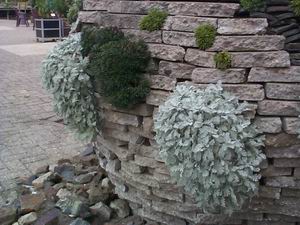
Artemesia stellata 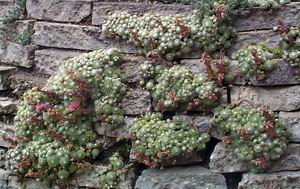
Sempervivum arachnoideum 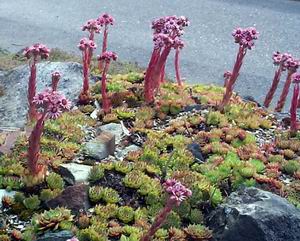
Sempervivum tectorum |